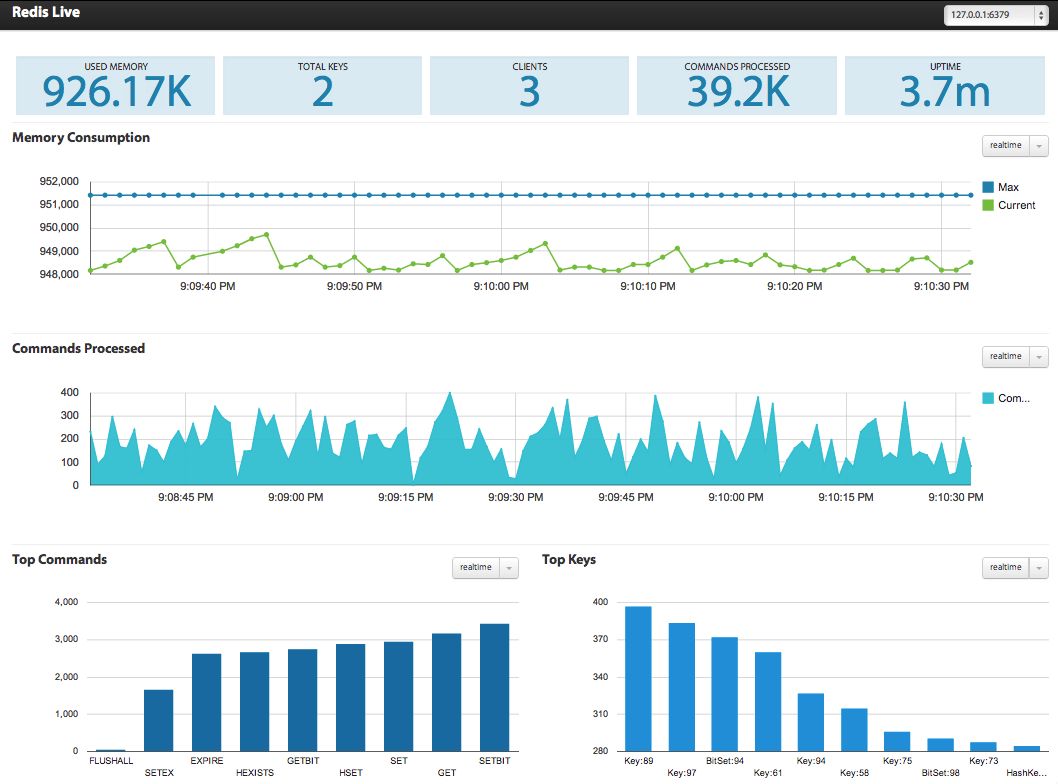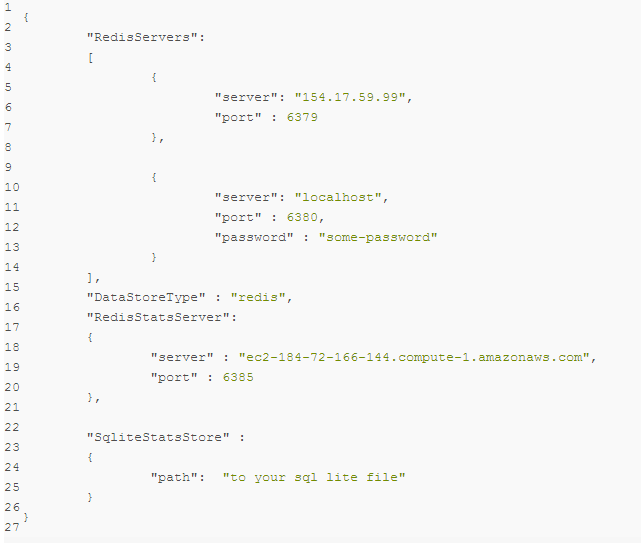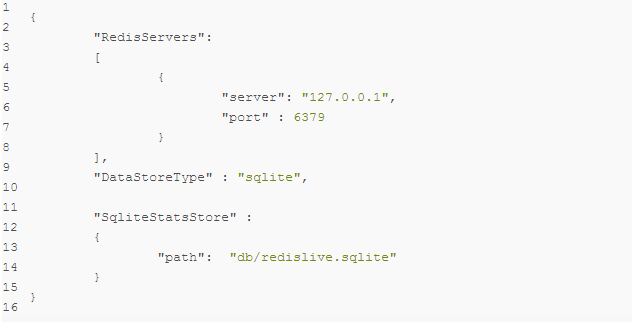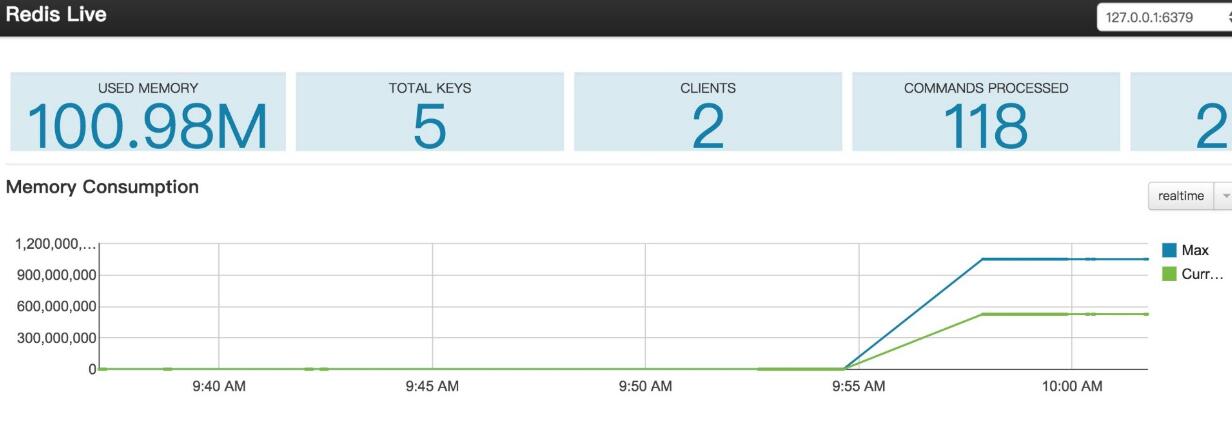Analyzing RedisLive: Redis's visual graph monitoring platform
As an open source Redis graphical monitoring tool, RedisLive provides monitoring of the memory usage of Redis instances, received client commands, number of received requests, and keys. The working principle of RedisLive is based on the INFO and MONITOR commands of Redis. The current running data of the Redis instance can be obtained by sending INFO and MONITOR commands to the Redis instance.
The graphical display interface provided by RedisLive is as shown below:

Install
RedisLive is implemented in Python and uses Tornado as its own web server. No additional compilation process is required to run RedisLive. After downloading the RedisLive code, you only need to install the dependent Python extension packages to run it directly.
You can download the latest RedisLive source code through Git:
git clone https//githup.com/kumarnitin/RedisLive.git
Go to the downloaded RedisLive directory and you can see that the Python extension packages that RedisLive depends on have been written in the requirements.txt file. The content of requirements.txt is as follows:
argparse==1.2.1 python-dateutil==1.5 redis tornado==2.1.1
Friends who are familiar with Python must also feel very familiar with the requirements.txt file. Use the following command to install the expansion package inside (specify Douban source to install faster):
pip install -r requirements.txt -i http://pypi.douban.com/simple/–trusted-host pypi.douban.com
After installing the dependencies, you can run RedisLive. Enter the RedisLive/src directory and you can see the redis-live.conf.example file. This file is an example configuration file for RedisLive. The content is as follows:

- RedisServers: List of monitored Redis instances, RedisLive supports monitoring multiple Redis instances at the same time
- RedisStatsServer: Redis instance used to store monitoring data. This configuration is different from RedisServers. RedisLive does not monitor RedisStatsServer. RedisStatsServer is only used to store monitoring data.
- DataStoreType: The storage solution for monitoring data, which can be configured as redis or sqlite
- SqliteStatsStore: sqlite configuration for storing monitoring data
The redis-live.conf (need to remove the .example suffix) used by our instance is set as follows:

That is, the monitored Redis instance is 127.0.0.1:6379, and the sqlite function is used to store the monitoring data solution. The sqlite database path is
db/redislive.sqlite
After the configuration is complete, you can run RedisLive. The operation of RedisLive consists of two parts (in the RedisLive/src directory), redis-monitor.py is used to send INFO and MONITOR commands to the Redis instance and obtain their returns, redis-live.pyUsed to run the web server.
We first start the redis-monitor.py script and set the duration parameter to 120 seconds. The duration parameter specifies the running duration of the monitoring script. For example, if it is set to 120 seconds, that is, after 120 seconds, the monitoring script will automatically exit and print the shutting down... prompt on the terminal.
./redis-monitor.py --duration=120
Next start the web server:
./redis-live.py
Open the browser, enter http://localhost:8888/index.html in the address bar, and press Enter to see the monitoring data of the Redis instance.

It should be pointed out that since the redis-monitor.py script uses MONITOR commands and INFO commands to the Redis instance to obtain monitoring data, the MONITOR command has a greater impact on the performance of the Redis instance. , Therefore, for the deployment of redis-monitor.py in the production environment, you need to set a more appropriate duration parameter and use crontab to execute the script regularly.
Reference materials- https://github.com/nkrode/RedisLive
- http://www.nkrode.com/article/real-time-dashboard-for-redis
- http://wxmimperio.tk/2016/02/25/Redis-Monitor-Tools/
- In-depth understanding of Redis, written by Jeremy Nelson, translated by Wang Jianan, Electronic Industry Press, April 2017
- http://redis.io/commands/monitor
The above is the detailed content of Analyzing RedisLive: Redis's visual graph monitoring platform. For more information, please follow other related articles on the PHP Chinese website!

Hot AI Tools

Undresser.AI Undress
AI-powered app for creating realistic nude photos

AI Clothes Remover
Online AI tool for removing clothes from photos.

Undress AI Tool
Undress images for free

Clothoff.io
AI clothes remover

Video Face Swap
Swap faces in any video effortlessly with our completely free AI face swap tool!

Hot Article

Hot Tools

Notepad++7.3.1
Easy-to-use and free code editor

SublimeText3 Chinese version
Chinese version, very easy to use

Zend Studio 13.0.1
Powerful PHP integrated development environment

Dreamweaver CS6
Visual web development tools

SublimeText3 Mac version
God-level code editing software (SublimeText3)

Hot Topics
 What computer configuration is required for vscode
Apr 15, 2025 pm 09:48 PM
What computer configuration is required for vscode
Apr 15, 2025 pm 09:48 PM
VS Code system requirements: Operating system: Windows 10 and above, macOS 10.12 and above, Linux distribution processor: minimum 1.6 GHz, recommended 2.0 GHz and above memory: minimum 512 MB, recommended 4 GB and above storage space: minimum 250 MB, recommended 1 GB and above other requirements: stable network connection, Xorg/Wayland (Linux)
 Linux Architecture: Unveiling the 5 Basic Components
Apr 20, 2025 am 12:04 AM
Linux Architecture: Unveiling the 5 Basic Components
Apr 20, 2025 am 12:04 AM
The five basic components of the Linux system are: 1. Kernel, 2. System library, 3. System utilities, 4. Graphical user interface, 5. Applications. The kernel manages hardware resources, the system library provides precompiled functions, system utilities are used for system management, the GUI provides visual interaction, and applications use these components to implement functions.
 vscode terminal usage tutorial
Apr 15, 2025 pm 10:09 PM
vscode terminal usage tutorial
Apr 15, 2025 pm 10:09 PM
vscode built-in terminal is a development tool that allows running commands and scripts within the editor to simplify the development process. How to use vscode terminal: Open the terminal with the shortcut key (Ctrl/Cmd). Enter a command or run the script. Use hotkeys (such as Ctrl L to clear the terminal). Change the working directory (such as the cd command). Advanced features include debug mode, automatic code snippet completion, and interactive command history.
 How to check the warehouse address of git
Apr 17, 2025 pm 01:54 PM
How to check the warehouse address of git
Apr 17, 2025 pm 01:54 PM
To view the Git repository address, perform the following steps: 1. Open the command line and navigate to the repository directory; 2. Run the "git remote -v" command; 3. View the repository name in the output and its corresponding address.
 Where to write code in vscode
Apr 15, 2025 pm 09:54 PM
Where to write code in vscode
Apr 15, 2025 pm 09:54 PM
Writing code in Visual Studio Code (VSCode) is simple and easy to use. Just install VSCode, create a project, select a language, create a file, write code, save and run it. The advantages of VSCode include cross-platform, free and open source, powerful features, rich extensions, and lightweight and fast.
 How to run java code in notepad
Apr 16, 2025 pm 07:39 PM
How to run java code in notepad
Apr 16, 2025 pm 07:39 PM
Although Notepad cannot run Java code directly, it can be achieved by using other tools: using the command line compiler (javac) to generate a bytecode file (filename.class). Use the Java interpreter (java) to interpret bytecode, execute the code, and output the result.
 What is the main purpose of Linux?
Apr 16, 2025 am 12:19 AM
What is the main purpose of Linux?
Apr 16, 2025 am 12:19 AM
The main uses of Linux include: 1. Server operating system, 2. Embedded system, 3. Desktop operating system, 4. Development and testing environment. Linux excels in these areas, providing stability, security and efficient development tools.
 How to run sublime after writing the code
Apr 16, 2025 am 08:51 AM
How to run sublime after writing the code
Apr 16, 2025 am 08:51 AM
There are six ways to run code in Sublime: through hotkeys, menus, build systems, command lines, set default build systems, and custom build commands, and run individual files/projects by right-clicking on projects/files. The build system availability depends on the installation of Sublime Text.






